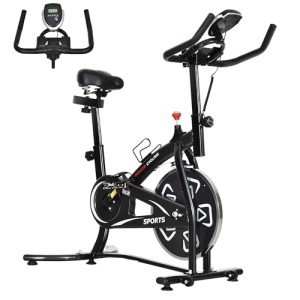Creating the Ultimate Home Gym: A Comprehensive Guide
In the last few years, home gyms have surged in popularity, especially as people have actually sought to maintain their fitness routines amidst altering situations and uncertainties. Establishing Gym Bicycle offers benefit, expense savings, and the ability to exercise in a customized environment. This short article will detail the important components of creating a practical home gym, consisting of essential equipment factors to consider, area allotments, and motivational strategies.
Why Invest in a Home Gym?
The decision to develop a home gym can considerably affect fitness and overall well-being. Here are a couple of engaging reasons to think about:
- Convenience: With a home gym, there's no requirement to take a trip to a gym. Exercises can be set up around personal commitments, making it easier to fit exercise into a hectic day.
- Cost-Effectiveness: While there is an upfront financial investment, gradually, having your own equipment eliminates ongoing month-to-month charges connected with gym subscriptions and travel.
- Modification: Home health clubs can be tailored to personal fitness choices. Whether one favors strength training, yoga, or cardio exercises, the area can be created to fulfill particular workout needs.
- Privacy: Exercising in the house supplies a level of convenience not always found in a public gym, enabling people to focus on their exercises without the pressure of onlookers.
Secret Equipment for Your Home Gym
When it concerns gearing up a home gym, the options can be overwhelming. However, it is essential to think about objectives, readily available space, and spending plan. Here's a list of essential equipment categories that can accommodate different fitness routines:
1. Cardiovascular Equipment
- Treadmill: Work on endurance and cardiovascular health with adjustable speeds and slopes.
- Stationary Bicycle: Perfect for low-impact cardio and terrific for interval training.
- Rowing Machine: Provides a full-body workout that emphasizes strength and endurance.
- Dive Rope: A portable and highly reliable cardio tool, perfect for conditioning exercises.
2. Strength Training Gear
- Dumbbells: Versatile and available in numerous sizes, they can be used for numerous exercises.
- Resistance Bands: Ideal for those with restricted space and can boost strength exercises significantly.
- Kettlebells: Great for dynamic exercises that combine strength and cardio.
- Barbell and Weight Plates: For major lifters, important for constructing general strength.
3. Practical Fitness Tools
- Yoga Mat: Essential for yoga, stretching, and bodyweight workouts.
- Stability Ball: Useful for core stability workouts and improving balance.
- Medication Ball: Can be utilized for numerous toss and lift exercises, enhancing practical strength.
4. Tech Gadgets
- Fitness Tracker: Helps keep track of workouts, steps, and total activity level.
- Mobile phone Apps: Many apps supply guided exercises and track progress.
- Virtual Classes: Subscriptions for online fitness classes can include range and inspiration.
Designing Your Home Gym Space
Factors to Consider:
- Location: Find an area that provides enough room for motion, such as a garage, basement, spare space, or perhaps outdoors if weather condition permits.
- Floor covering: Invest in floor covering that supplies support and cushioning, such as interlocking foam tiles or rubber flooring.
- Lighting and ventilation: Ensure the area is well-lit and ventilated to produce a comfy workout environment.
- Mirror: Including a mirror can aid with kind and inspiration.
Sample Home Gym Layout:
- Location: Spare bedroom or committed corner in a home
- Equipment: Treadmill versus one wall, a rack for dumbbells, a yoga mat in the center, and resistance bands hanging.
Maintaining Motivation in your house Gym
Even with a perfect setup, preserving inspiration can be tough. Here are several methods to keep the momentum going:
- Set Clear Goals: Establish short-term and long-term fitness objectives to stay focused and stimulated.
- Produce a Schedule: Treat workout sessions like essential consultations by scheduling them into life.
- Variety is Key: Mix up exercises to avoid boredom and improve different muscle groups.
- Incorporate Music: Create a stimulating playlist to boost mood and interest during exercises.
- Accountability Partner: Partner with a friend or relative to check-in and share progress.
Frequently Asked Questions About Home Gyms
1. What is the very best equipment for a novice's home gym?
For newbies, a few essential pieces can provide a varied variety of exercises: a set of dumbbells, resistance bands, a yoga mat, and a dive rope.
2. Just how much area do I require for a home gym?
The amount of area depends on the type and volume of equipment you choose. Ideally, a space of at least 50-100 square feet need to suffice for a fundamental setup.
3. Can I get fit without costly equipment?
Absolutely! Bodyweight workouts, yoga, and free-weight workouts can provide substantial fitness results without high expenses.
4. What should I prioritize when developing my home gym?
Concentrate on quality over amount. Select multi-functional equipment that fits your fitness goals and comfy space to encourage routine use.
5. How can I maintain my motivation to exercise at home?
Establishing a routine, setting goals, blending exercises, and involving others can all help to sustain inspiration.
Developing a home gym can be a vibrant and rewarding financial investment in one's health and wellness. By attentively choosing the best equipment, creating a motivating workout area, and keeping motivation, people can effectively overcome barriers and welcome a much healthier way of life. Whether one is a skilled athlete or a fitness newcomer, the flexibility and benefit of a home gym make it an ideal option for busy schedules and individualized fitness journeys.

